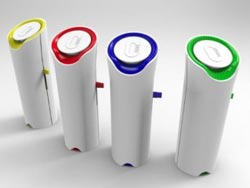Scents that are Sent by Phone

Prototype of the oPhone that can send a scent to someone far away. <br>
What if you forgot about Valentine’s Day, and now it’s too late to send that certain someone roses. Someday, you’ll at least be able to send their scent.
A Paris laboratory under the direction of David Edwards, Michigan Technological University alumnus, has created the oPhone, which will allow odors—oNotes—to be sent, via Bluetooth and smartphone attachments, to oPhones across the state, country or ocean, where the recipient can enjoy American Beauties or any other variety of rose.
The scents can be sent via email, tweet, or text.
The secret is in accurate scent reproduction, locked in chips plugged into the devices. Odors are captured in wax after they are perfected using “The Nose”– an aroma expert at Le Lab in Paris, Marlène Staiger — who deconstructs the scents.
“Imagine you are online and want to know what a particular brand of coffee would smell like,” Edwards says. “Or, you are in an actual long line waiting to order. You just tap on the oNote and get the experience.”
For the full story, see http://www.mtu.edu/news/stories/2014/february/story102876.html
To contact David Edwards, email his associate, Xaviere Masson, at xaviere@artsciencelabs.org or call 011-331-78-94-86-19 or cell 011-336-73-43-13-05 in Paris, France (six hours later than Eastern Standard Time).
Media Contact
More Information:
http://www.mtu.edu/news/stories/2014/february/story102876.htmlAll latest news from the category: Information Technology
Here you can find a summary of innovations in the fields of information and data processing and up-to-date developments on IT equipment and hardware.
This area covers topics such as IT services, IT architectures, IT management and telecommunications.
Newest articles

A universal framework for spatial biology
SpatialData is a freely accessible tool to unify and integrate data from different omics technologies accounting for spatial information, which can provide holistic insights into health and disease. Biological processes…

How complex biological processes arise
A $20 million grant from the U.S. National Science Foundation (NSF) will support the establishment and operation of the National Synthesis Center for Emergence in the Molecular and Cellular Sciences (NCEMS) at…

Airborne single-photon lidar system achieves high-resolution 3D imaging
Compact, low-power system opens doors for photon-efficient drone and satellite-based environmental monitoring and mapping. Researchers have developed a compact and lightweight single-photon airborne lidar system that can acquire high-resolution 3D…





















